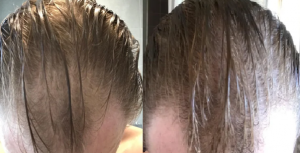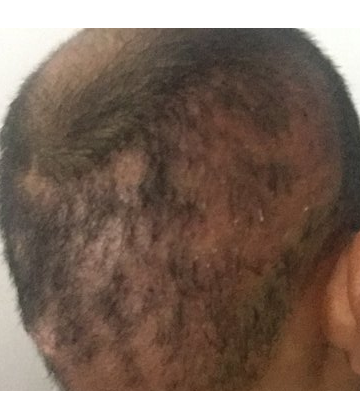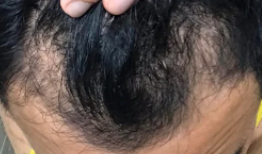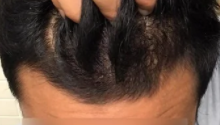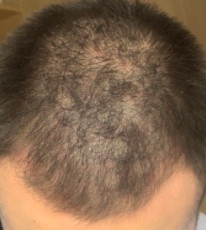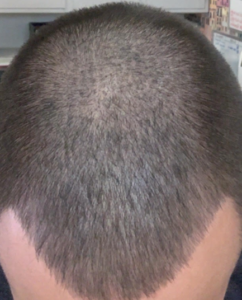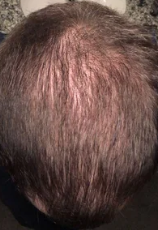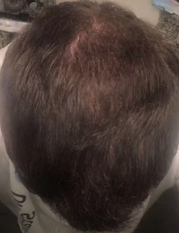I‘m from Germany and I suffer from hairloss. I was prescribed fin around 2 years ago. Recently it got worse and I went to a another dermatologist, since I moved places. He told me that he doesnt recommend taking fin and instead take Alfatradiol (apparently it has the same effect as fin but its topical?). Have you heard of this? The product is called Ell-Cranell. I cant seem to find a lot of studies.
Alfatradiol is a weak estrogen and 5-reductase inhibitor medication which is used topically in the treatment of pattern hair loss (androgenic alopecia or pattern baldness) in men and women. You might be better off with topical finasteride plus minoxidil as these are stronger medications.
I got an FUT 3 years ago. My scar unfortunately is “raised” and wider than expected. I’m not sure if it just healed wrong, or surgeon error. I was originally told my hair would need to be cut to a “5” for it to be unnoticeable, but it takes more like an “8” or “9”. I use dermatch or fibers to cover it with shorter hair.
A few months ago, I decided to get SMP on it. I had 5 sessions, and the ink just didn’t stick at all. The practitioner said it was due to the scar being “raised”. This was a couple thousand dollars, so I’m not feeling great about it.
Should I have something done to the scar before attempting something like SMP again? What about grafting some hairs into the scar? I’m not sure if my scar is hypertrophic, a keloid, or what. I just don’t want to spend more money on something that won’t work.
We treat raised scars with Kenalog injections which flatten then out (sometimes it takes a few months and more than one injection). Then I do the SMP into normal scars. See here: https://scalpmicropigmentation.com/gallery/scar-covering/
Can you explain more about the hair weight? You’re saying patient ones hair weighs more, and is 4 times thicker than patient twos thin/fine hair, which weighs 1/4 of first patient? Do I have that right? Is hair weight the same as hair volume?
How many grafts have each of those patients had? Both had the same amount of grafts?
Then how come every time someone gets a hair transplant they’re asked how many grafts they got? If 1,000 grafts on patient one could equal 4,000 grafts on another patient, the number of grafts doesn’t mean much without also knowing hair thickness/volume numbers as well. Do I have this correct?
Last question lol, when someone has fine hair being 1/4 the weight of average, do they usually have 4x the number of grafts in their donor area? So thick hair will have 4,000 total donor and fine hair can have 16,000 donor grafts?
Thank you I’m advance! This is a subject I’ve rarely seen talked about. It’s always ONLY how many grafts.
Think of this as building a fence. You have three types of wood 1×1″, 2×2″ and 4×4″. If you built the fence with 4×4 it would be a better fence than with 1×1, Four 1×1 = a singe 2×2 and four 2×2 equals a single 4×4. This is essentially comparable to fine, medium and coarse hair. Although the ratios are not the same a fine hair is 30 microns, a medium hair is 60 microns and a coarse hair is 90-100 microns, the metaphor does apply.
If this doesn’t explain it, please reply.
What does that mean in terms of my donor area as I had 2000 grafts?
The grafts used from the donor area are lost forever. There is no regeneration of the donor area Most people do not deplete the donor area in a single hair transplant. I would certainly go back to speak with your doctor and ask your doctor why it failed. I can’t give you any explanation other than to say that most failed hair transplants, in the absence of dermatological autoimmune diseases, are technical in nature. A 2,000 graft FUE procedure can be 30 percent of the average Caucasian’s donor supply and 40% percent for Asians as they tend to have less overall hair. From the picture below, it looks like your donor area has been maxed-out and FUE would not be possible going forward based upon what is seen in this picture showing very significant donor site depletion. To me, this reflects that you had a significantly lower than normal donor hair density before this process was started. Your surgeon should have told you this before he recommended FUE. Now with your donor area so depleted and a failed hair transplant and a see-through donor area which will not go away, you don’t have many options. Any more FUEs will only make it worse and this donor area can’t possibly yield enough hair to give you any reasonable transplant result. The only solution to this problem is the use of Scalp Micropigmentation which will make your donor area ‘look’ normal and it also might help the recipient area but you would have to see an expert in this area to fond out more about your options. See here for the limits for FUE surgery defined in one of my previous post in the Hair Transplant Forum: https://baldingblog.com/2017/07/21/many-fue-grafts-many-fues-grafts-one-know-safe-limits/ and here for information on Scalp Micropigmentation: https://scalpmicropigmentation.com/
More and more patients are experiencing over zealous surgeons who take out too many grafts from their donor area in doing FUE. I know that many patients want a lot a grafts so that they can get their hair back as quickly as possible, but pushing the envelope is a real problem as many men, who have donor densities that are not high, get this type of result and eventually may become bald in the back of their heads. If some of the hair does not recover (some of what we see is the result of shock loss), then the only option to treat this is scalp micropigmentation (https://scalpmicropigmentation.com/scar-covering/). I have discussed the limitations of FUE in previous posts here: https://baldingblog.com/2017/07/21/many-fue-grafts-many-fues-grafts-one-know-safe-limits/
This is a terrible design of a hair transplant, an upside down heard. No body balds this way so I can’t imagine what the person who did this had in mind. Add ot the terrible design is the cereal looking granular recipient sites. Again, I feel sorry for this patient.
It is my best interest to continue with finasteride, Rogaine and microneedling however, I’m a bit concerned as to whether fin is losing efficiency or so. I am wanting to get a hair transplant in the nearby future. It is my intention to have the FUE procedure and have SMP to add to the density once the results had healed.
Thanks for writing to me. Your results from finasteride and microneedling are fantastic. At 20 years old, you have achieved the goal and I would continue to do all three (minoxidil, finasteride and microneedling once a week) with the hope that this will continue to improve your situation. At 20 there is no reason to do a hair transplant and if you are lucky and the finasteride and minoxidil with occasional microneedling holds on to your hair, you may not need a hair transplant for years to come. Read this post: https://baldingblog.com/22-year-old-received-a-hair-transplant-of-2800-grafts-from-reddit/
What are the chances the regrowth I have from microneedling my scalp is “permanent”. I have diffuse thinning and microneedling has given me regrowth without any topicals.
I am fairly certain that these new hairs will not be permanent. They may last as long as a single hair cycle which is usually 2-3 years for the average young male. This is an educated guess, of course.
Page 6 of 8

